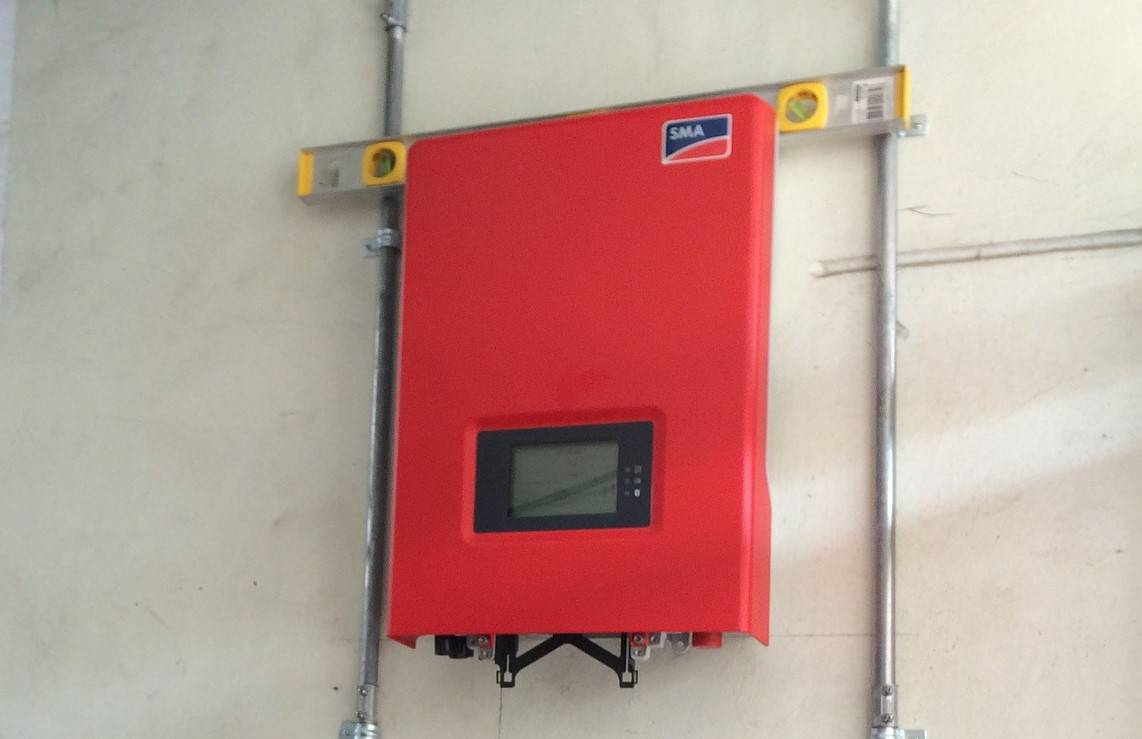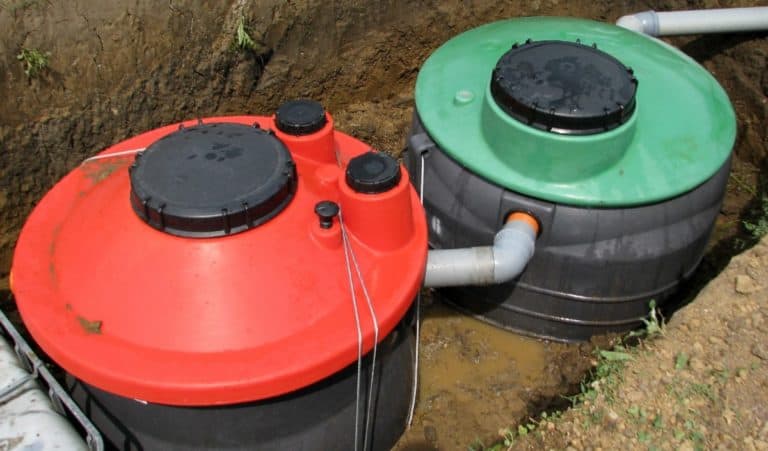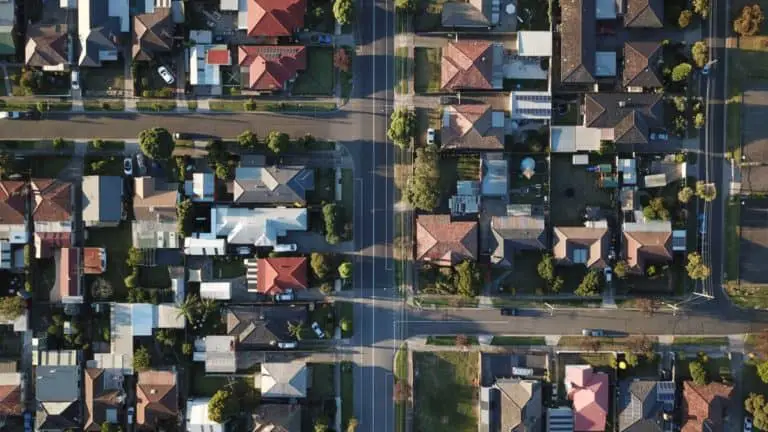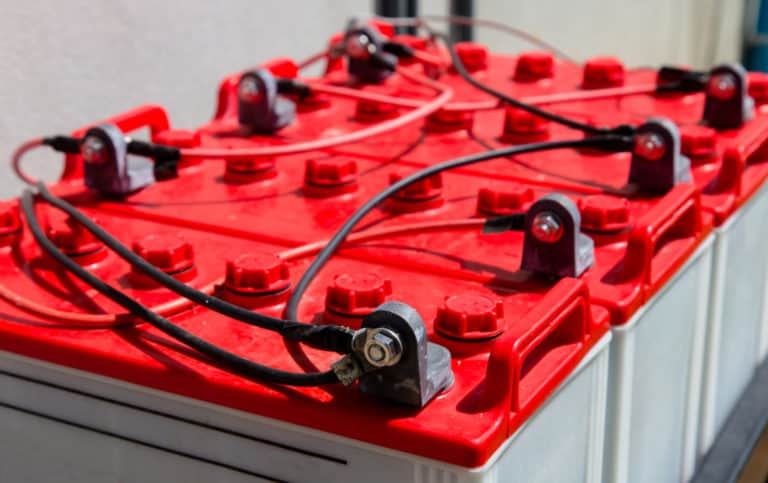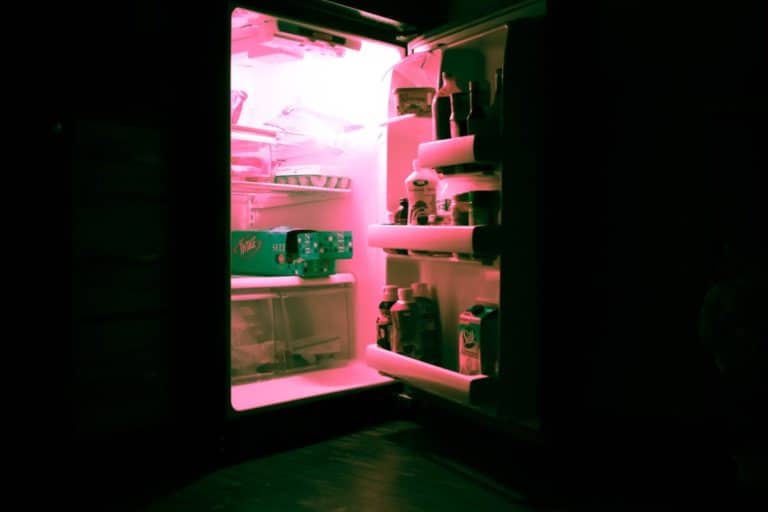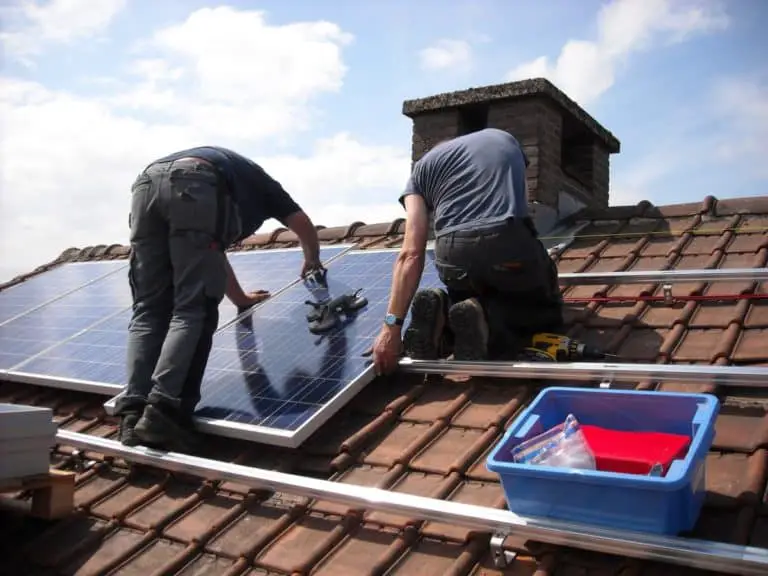Guide to Off-Grid Solar Inverters
If you are interested in having a solar power system installed in your home, it is important to know what you will need. The heart of any solar system, whether off or on-grid, is the inverter. To ensure that you select the right one for your system, it is vital to understand its features, how it works, and what it does.
An off-grid solar inverter manages the conversion of DC electricity produced in the solar panels into AC that can be used to run your home. The size of the inverter you will need depends on the amount of power produced by your solar panels. There are different types with different features to suit different budgets and situations.
Gaining an understanding of inverters is crucial to being able to set up a solar panel system. If you’re planning to install it yourself or just want to understand the role of an inverter better, this guide will give you everything you need to know.
You may also be interested to read: Best solar power equipment for your off-grid home.
Table of Contents
What is an off-grid inverter?
An inverter is a device that converts DC electricity into AC electricity. An off-grid inverter is one that is specifically designed to be used in systems with no connection to the grid.
In off-grid solar systems, the inverter takes DC electricity from the solar panels or battery storage and changes it into the AC power that is used in most homes. Because they don’t need to include the ability to give or receive power from the grid, they are often cheaper than grid-tied models.
Related reading: How many solar panels do I need to run my home off-grid?
What are DC and AC?
Direct current (DC) is when the electrons in a circuit flow only in one direction, from positive to negative. This is the type of electricity used by batteries and produced by solar panels. It is also the type used by many household electronics like computers and consoles. Complicated electronic systems like these depend on the electricity to flow in one direction to activate each component in the correct order.
Alternating current (AC) is when the electron flow constantly switches direction between 50 and 60 times a second (50-60 hertz). AC is often used because it is the most efficient way to transport large amounts of electricity long distances.
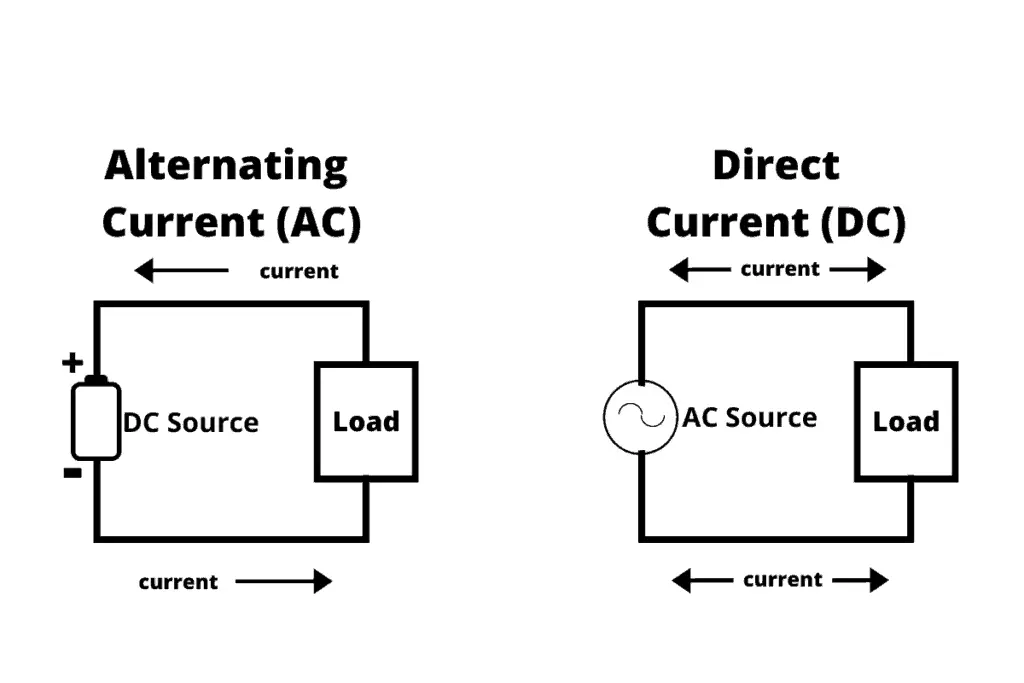
Because of this, the electricity grid and our home systems are all designed to receive AC power. Simple electrical devices like lights, air conditioners, and washing machines work directly from the AC but include power packs that rectify it back to DC.
Why should solar electricity be converted to AC?
Because homes and electrical devices are designed to expect AC power, solar systems use inverters to create a power supply that mimics that of the grid.
How do solar inverters work?
An inverter uses a transformer to convert direct current to alternating current. A transformer uses a phenomenon called electromagnetic induction to alter the voltage of electricity. This is done by passing power through one coil to create a magnetic field.
A second coil is placed near the first, and the presence of the magnetic field induces electricity to be present in both coils. By using a different number of loops in each coil, it is possible to pass electricity into the first coil at one voltage and create a new voltage in the next.
A transformer will only work if the magnetic field produced by the first coil is created by AC. The creation of electricity in the second coil is caused by constantly changing the polarity of the magnet, and consequently, the electricity produced in the second coil is also alternating. If you pass direct current into the first coil, no current is created in the second.

An inverter works by using a circuit to quickly swap the direction of a DC current in the first coil. This creates the illusion of alternating current in the first coil and stimulates AC electricity in the second.
However, the transformer doesn’t completely solve the problem. Alternating current typically created in an induction coil doesn’t instantly switch from one direction to the other. It swings naturally, and when plotted on a graph you can see that as the voltage changes from a negative to a positive value, it creates a curve called a sine wave. When an inverter creates alternating current, the changes from positive to negative voltage are abrupt and create a pattern of square waves.
Square wave inverters
These are the simplest form of inverter because they leave the resulting AC power in its square wave pattern. Because there is no extra conversion of the current, there is no need for lots of additional components, so they are easier to make and cheaper.
This type efficiently converts DC to AC, but the resulting power is not as refined as standard AC. AC from square wave inverters is suitable for some AC appliances, but it may cause them to heat up or emit a humming noise. Some sensitive equipment can’t be used effectively when powered by square wave AC.
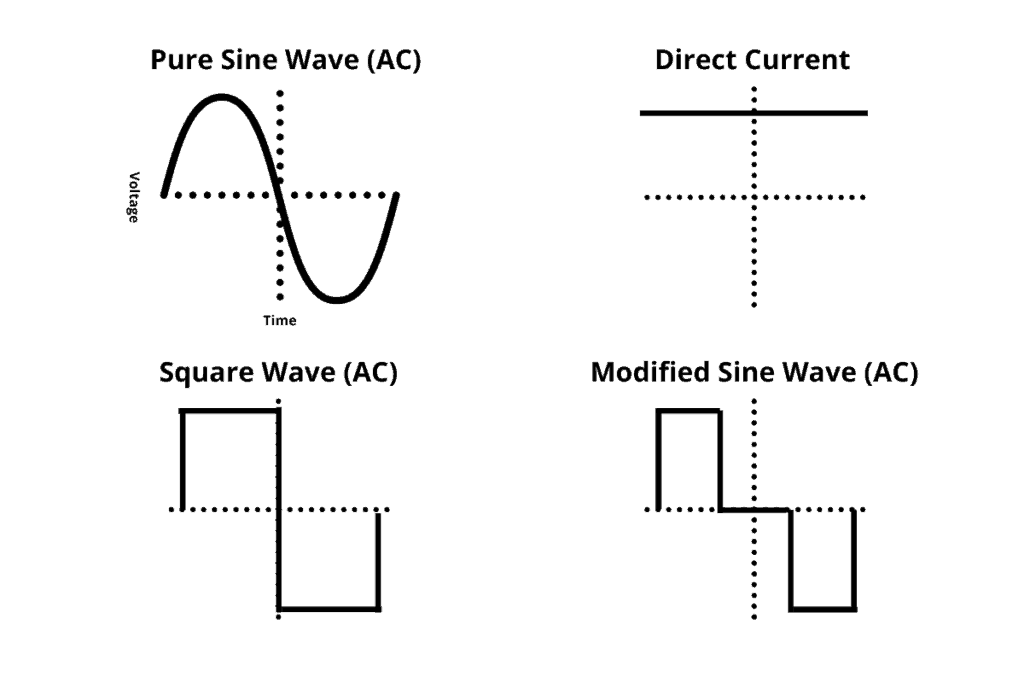
Modified sine wave inverters
A modified sine wave inverter has extra components to add a pause at 0 volts every time the current changes direction. This creates a staggered square wave that is slightly closer to AC’s pure sine form. By adding this pause, some of the negative features of sine waves are reduced. There is less humming and reduced heat build-up.
Some AC appliances that might not work well with square wave AC can be powered with modified sine wave electricity. However, devices that use AC motors like fridges, microwaves, and compressors will not run as well as they should and may develop damage over time.
The attraction of a modified sine wave inverter is that it is more effective than a square wave model and significantly cheaper that one that produces pure sine waves.
Sine wave inverter
Sine wave inverters are the most expensive, but they are the best choice to convert power from an off-grid solar system for use in your home. To take the square wave from the transformer and return it to a sine wave requires extra components. This means that sine wave inverters are the most complicated to make and the most expensive.
When you need power to run your home, you can use AC from a sine wave inverter confidently, knowing that it won’t cause damage to your appliances. If you are running a small off-grid solar system to power simple items like lights, you may consider a different type, but if you want to use more sophisticated equipment like televisions or microwaves, sine waves are essential.
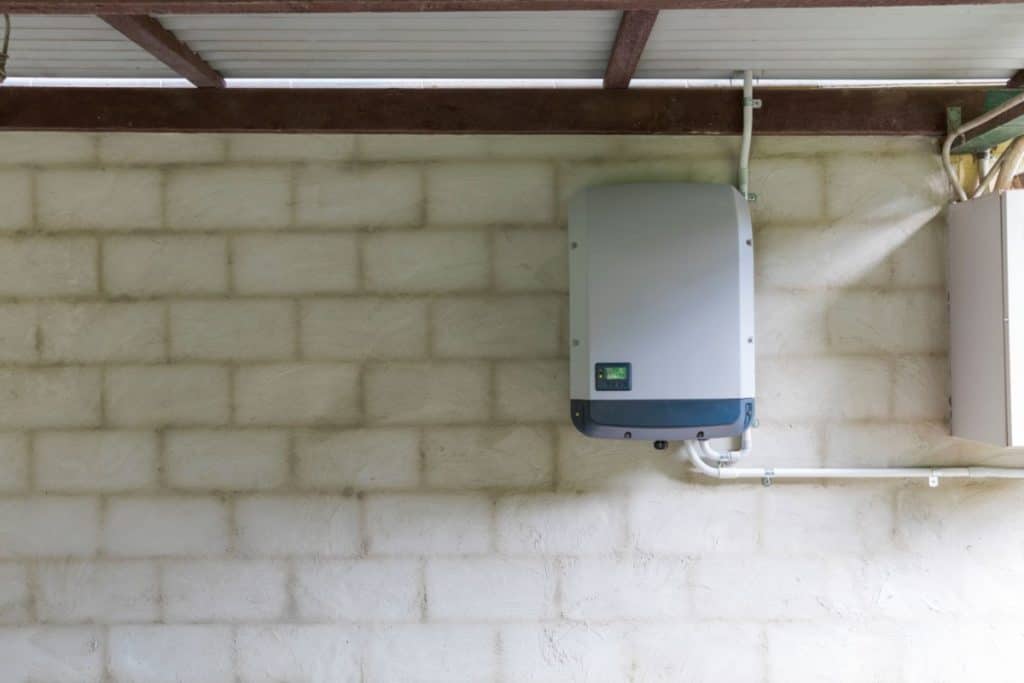
Where are inverters installed in an off-grid solar system?
Inverters are usually placed between the batteries and your home’s electrical system. In most systems, solar panels are connected to a charge controller, which charges the batteries, and then the batteries send a charge to the inverter, which in turn powers your home appliances.
Some charge controllers connect to both the battery and the inverter and can switch between sending a charge to it and charging the battery. This allows it to switch between the two when necessary.
Central/string inverters
In a grid-tied system where batteries and charge controllers are not required, a central inverter, also known as a string inverter, is used. ‘Central’ refers to where it is positioned in the circuit. It treats all the panels in the solar array as if it is one.
All of the panels are wired in series with one inverter as if strung together. This is the most common way of setting up off-grid systems because it is cheap and easy to setup.
The drawback of this system is that if one of your panels is shaded or stops working, it affects the performance of the whole system. Off-grid inverters can also be set up like this, but it is the batteries or charge controller that takes the central position in the circuit with the solar panels. This is then connected to the inverter, so the effects on the system are the same as in grid-tied setups.
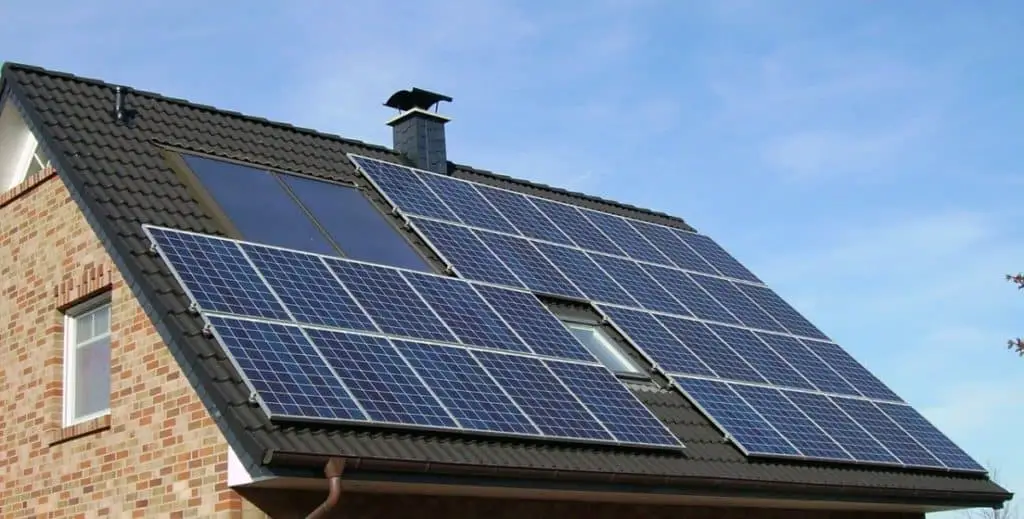
Microinverters
Microinverters are a way of preventing the problems of one solar panel affecting the whole system. Each panel is wired with its own small inverter. This way, if one stops working or is shaded, the effect on the whole system is minimal. This is an effective method to get the most from the system, but it requires buying multiple inverters and wiring them to each panel, which takes extra time and money.
Another advantage of this method is that if you want to add more solar panels, you don’t need to get a new central inverter. A new panel and micro inverter can easily be added with minimal alteration required to the broader system.
In off-grid systems, the microinverter modules are also equipped with charging facilities to divert DC power directly from the panel before it is converted to AC.
Micro parallel inverters
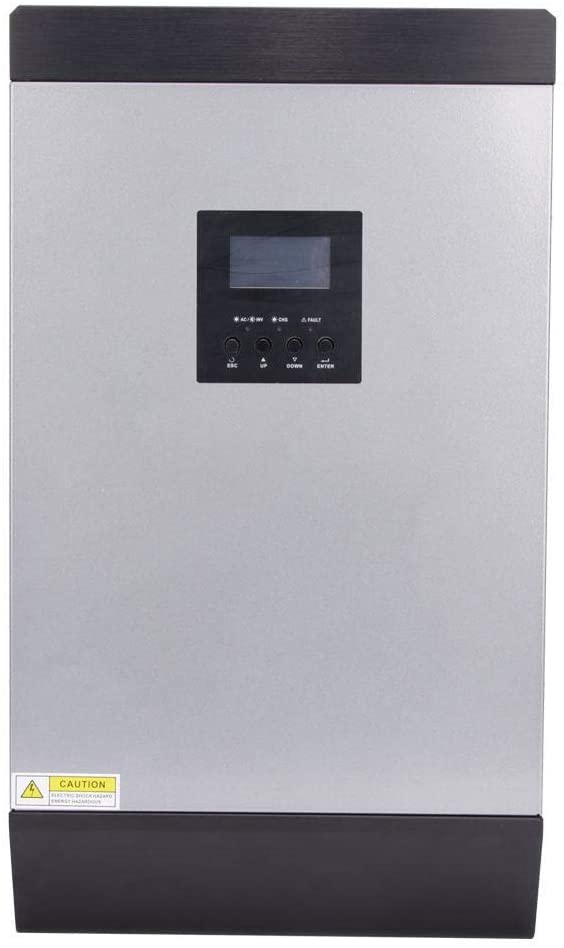
This is a newer system that uses the best of both central and micro-inverters. A single micro parallel inverter has separate channels for each panel wired to it. It works as a central inverter, but if one of the panels stops working, it switches to take power from the other three. This is an excellent way of getting the benefits of micro-inverters but only needing to install one.
Should I get a PWM or MPPT inverter?
Maximum Power Point Tracking is a system to maintain the maximum voltage produced from your solar panels. They can be up to 20% or 30% more efficient and can make the solar system more productive. However, MPPT is a feature only required in an inverter if it is tied to the grid.
A grid-tied inverter receives electricity directly from the solar panels, whereas an off-grid inverter receives it from your batteries or from a charge controller. For your off-grid system to benefit from MPPT, you will need to choose a charge controller with MPPT. Off-grid inverters with MPPT are available, but they are usually combination modules with charge controller and inverter all in one.
Pulse Width Modulation inverters and charge controllers provide a steady output at the same voltage no matter what the load is. This can work well, but in some cases, it causes a loss in efficiency.
What is an off-grid Inverter/charger?
In an off-grid system, you may want to add a generator as a backup. Generators are useful to charge the batteries if you have a run of cloudy days, and your power supply falls low. A generator produces AC electricity, so to charge the batteries, it must be rectified to DC. An inverter/charger works as a standard inverter converting DC to AC to power your home, but it also contains a rectifier to take AC from a generator, convert it to DC and use it to charge your battery.
Inverter/chargers are an excellent choice for off-grid solar systems. Having the additional security of a backup generator is useful, particularly during the greyer months of Winter.
It’s worth noting that if you have an inverter/charger to charge your batteries from an AC source like a generator, you will still need an additional charge controller to charge them using the DC power from your solar panels.
Can I use solar panels and an inverter without battery?
Battery storage is a crucial part of most off-grid solar panel systems. Because solar panels only produce electricity when the sun shines on them, you need a way to save the energy to use later. On-grid solar systems don’t require batteries because they use a method called ‘net metering.’
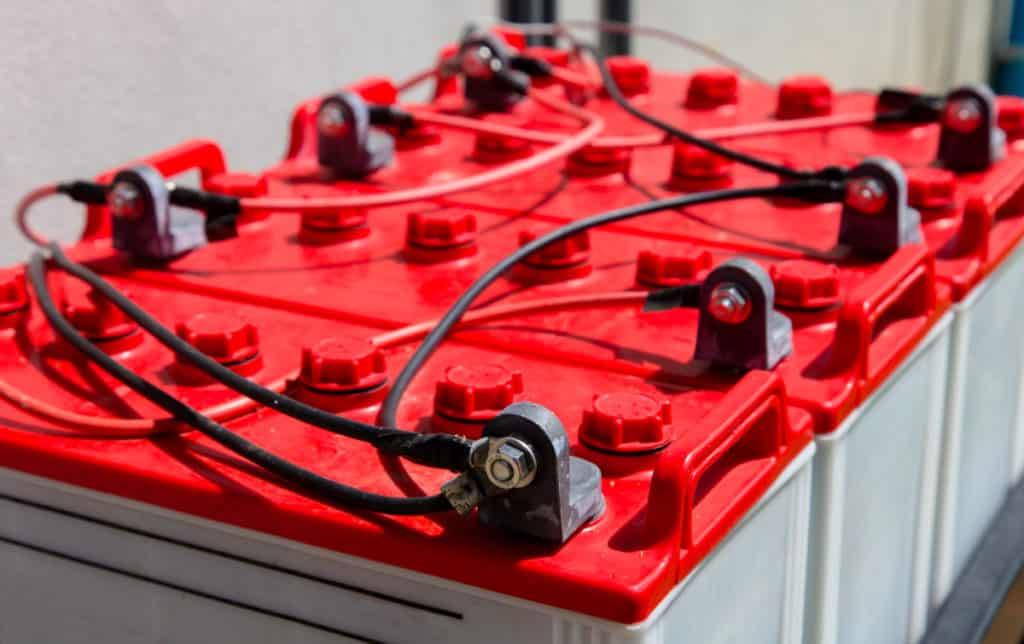
This means that the grid acts as a battery or power storage. Any excess electricity produced by solar panels is sent to the grid. With net metering, the amount sent is recorded, and that same amount of power can be withdrawn at a later date at no extra cost. Consequently, most on-grid solar systems don’t use battery storage.
In an off-grid system, it is possible to use a solar panel and inverter without a battery, but you will only be able to use power produced at the time of its production. This makes it unsuitable for powering a home because none of your lights would work on cloudy days or after dark. Small off-grid systems used to charge small devices, or run simple equipment, may be adequate without a battery, but in most cases, batteries are essential to off-grid solar.
Related reading: What is the best battery for a solar power system?
What size inverter will I need?
Power (Watts) Input: The power rating of your inverter should be close to that of your solar array. Some inverters will have a specified range of solar power that should be provided. It’s useful to remember that solar panels rated at 6.6kW will rarely, if ever, reach that value. Inverters tend to work best when used for longer at their maximum power, so if possible, match the input power to the upper wattage of the inverter.
Output: Most inverters will be allocated a continuous power output value and surge output value. The continuous power rating is the maximum power the inverter can deliver for a constant period. The surge rating will be higher and is the maximum power that can be provided for a short ‘surge.’
This is necessary because when you turn on some appliances, they use more energy in one hit than they do during regular use. Your inverter should have a surge power rating greater than the sum of power used by all your appliances if they were to surge simultaneously.
Most off-grid homes require inverters between 4 to 16kW of continuous power. 4kW should be enough for a small house, and 16kW should suit a large family home or homestead. To establish how much continuous power you need, add up the wattage of the appliances you want to use on your system.
Inverters come in a range of sizes. Here are some examples of the kW rating you can expect to find with off-grid inverters:
3900W, 4000W, 4400W, 5000W, 6800W, 10000W
Pure sine wave inverters of this size can range between $1,500 and $4,000
Size and compatibility
When buying an inverter, it is crucial to check that it will be compatible with the type or style of batteries you’re using as well as the system size. The input voltage of the inverter must match that provided by your battery bank. Most larger inverters will require an input of 48V. Some newer battery systems like the Tesla Powerwall2 use much higher voltages (400V), so they will require a compatible inverter.
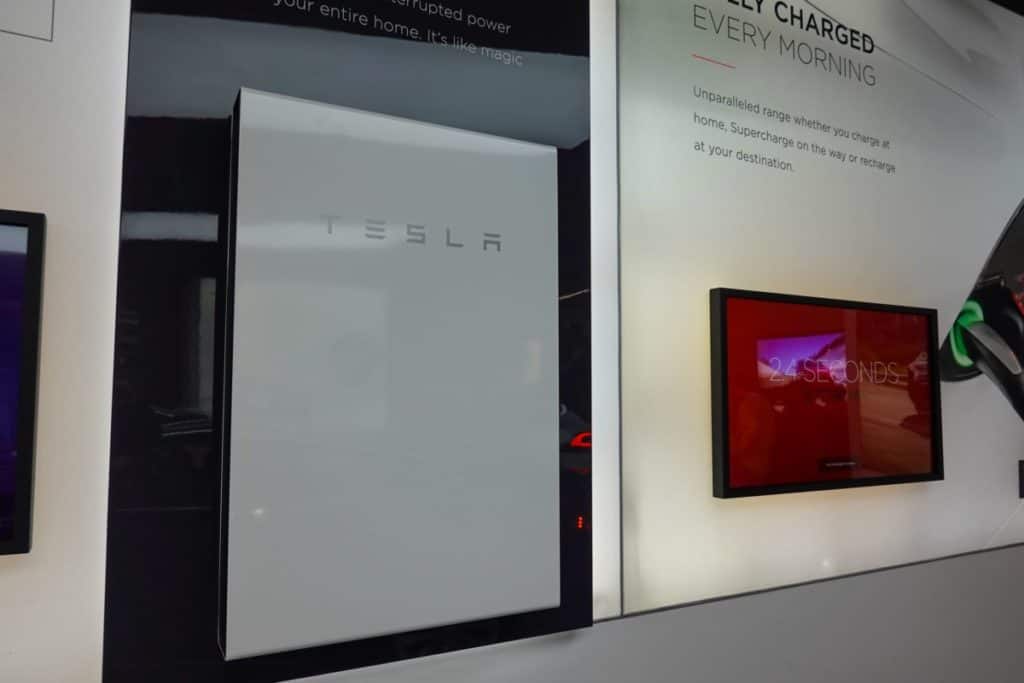
You can choose an inverter that gives the output voltage that your home system requires. This is often 120V or 240V.
Some types of batteries require specific types of inverters. For example, lithium batteries sometimes have onboard battery management systems. Batteries of this type require an inverter that is compatible with this system.
Monitoring software
Modern inverters have rapidly advanced, and now you have the option of systems that come with monitoring systems and precise control software. This means that your inverter is loaded with software that can make adjustments to all areas of the system to maximize efficiency. They can also provide detailed monitoring to let you view the solar production and energy consumption of your system.
Some systems display this information directly on screens mounted on the inverter; others have the functionality to email your details and even warn you of maintenance issues or errors in the system. If you choose a system like this, it will likely require specific compatible components, so they may only work with certain batteries and charge controllers.
If you want these options but can’t find a suitable inverter with these features, it is possible to use separate monitoring units that can be wired into your system to provide similar monitoring and control.
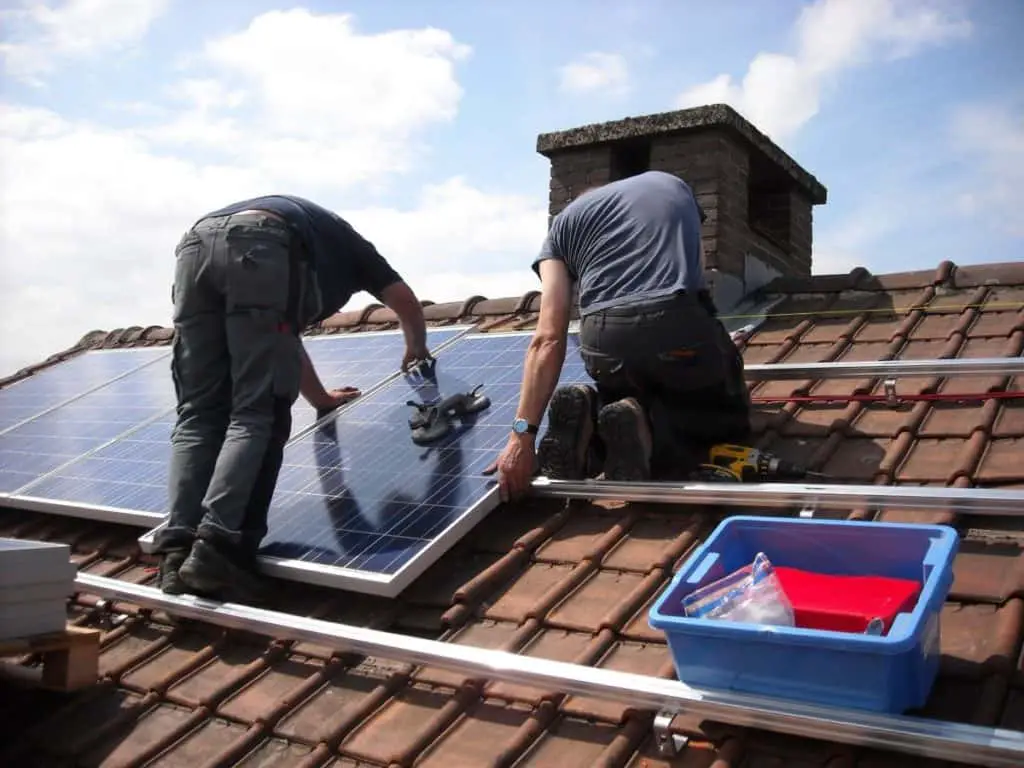
How long do off-grid inverters last
Most central inverters last between 10 and 15 years, it is likely that your inverter could be the first component in your solar system to need replacing. When you’re selecting an inverter, buy from a reputable company with a good reputation for aftercare.
Most inverters will require very little maintenance but may benefit from necessary checks every couple of years. Solar retailers usually sell inverters with five-year warranties and the option to pay for an extended 10-year warranty. It is always worth paying for the full ten years. Bear this in mind when choosing your inverter because spending a little more on a quality item now may save you thousands in the future.
What is the best off-grid inverter?
The best inverter for your off-grid home is one that:
- Meets your power needs – It should be able to cope with the maximum surge expected by your home appliances and provide more than enough continuous power if you were running all your devices at the same time. Leave some room here in case you find yourself upgrading appliances or buying new powered items for your home.
- Is bought alongside your panels and batteries – To get the best
overall experience from your system, don’t buy each component separately. Instead, decide how big your setup should be and what features it needs, then look for parts that are compatible with each other. This way, you may be able to take advantage of extra features, advanced efficiency, and monitoring software. Some companies even provide ‘pre-wired power centers,’ which are single units preloaded with an inverter, charge controller, remote control, and circuit breakers.
- Produces pure sine wave AC – A pure sine wave model is by far the
best choice and will provide the best overall experience for all your
appliances with no hum or extra heat. An inverter/charger is also the best choice because you have the capability to add an AC generator to charge your DC batteries should they need a boost.
- Meets legal requirements – In the US, home inverters should be UL 1741 listed and come with safety features and assurances.
- Can be monitored easily – Systems that can be easily monitored allow
you to correct any problems that arise quickly. Consequently, your inverter and the entire system is likely to be more efficient and last longer.
Related reading: How to choose an off-grid charge controller.
Check out my recommendations for equipment that will help you take your home off-grid.
